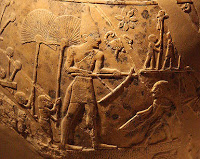The Early Kings of Hierakonpolis
 Archaeology Magazine - Interactive Dig
Archaeology Magazine - Interactive DigHierakonpolis (Nekhen) has long been a site of profound significance for the study of Egypt's beginnings, not just because of zombies, and not just for us today. Even the ancient Egyptians thought it was old, and venerated its early rulers, their names long forgotten, as the jackal headed Souls of Nekhen. While the sheer extent and diversity of the Predynastic (ca. 3800-3000 B.C.) remains (see introduction) attest the historic basis of their beliefs, recent discoveries in the elite cemetery at the site indicate these memories stretch back much further than we ever imagined. These new finds are also allowing us to tie up many loose ends around that site (while creating others) and put together a much more coherent picture of the early rise of Hierakonpolis and Egyptian civilization, although there is still much we need to find out.
Based on the still unparalleled Painted Tomb (Tomb 100), discovered by F.W. Green in 1899, it was believed that Hierakonpolis was at its peak in the Naqada IIC period, thus about 3500 B.C., a time of social change and economic development throughout Predynastic Egypt. One of the largest tombs of its time, the painted scenes on its walls containing elements that would go on to become characteristic of royal iconography proclaimed the royal status of its owner and his home town. But try as we might to find further evidence for this, everywhere we looked around the desert site, the extensive archaeological remains, which include breweries, food production installations (see 2007 Field Note 3), pottery kilns, and ceremonial centers (see Narmer's Temple), all dated some 300-400 years earlier (early Nagada II period). This level of complexity suggested that strong rulers had already been established well before the owner of the Painted Tomb, but it was not until 2000 that the first clear indications of their existence were finally uncovered (see Elite Cemetery). The discovery of the elaborate and clearly royal tomb (Tomb 23) in the elite cemetery, first summarized in a special report (see Special Report: New Finds from the Elite Cemetery), has since been supplemented by further exploration that have revealed a vast and unexpected architectural complex and a unprecedented view of the very beginnings of Egyptian kingship, civilization, and some if its more enduring characteristics.
- In The Field: Bead Making At Hierakonpolis
Archaeology Magazine Thanks to OsirisNet's most recent newsletter for pointing out that the Archaeology Magazine's Hierakonpolis "Interactive Dig" has been updated with an article about bead and bead making 2009, Field Note 3). With photos. The...
- Interactive Hierakonpolis Updated - 2009 Field Notes
Field Note 1 - Saving the Fort Field Note 2 - The Rock Art Survey The Interactive Hierakonpolis web pages have been updated on the Archaeology Magazine website with some fascinating information about work in the 2009 season. Both reports are accompanied...
- Hierakonpolis Interactive Dig Updated
Archaeology Magazine Thanks to Archaeology magazine's e-Update for the news that the Hierakonpolis Interactive Dig has been updated on Archaeology's website. It was a long, unseasonably hot and occasionally stressful season, but one filled with...
- Hierakonpolis 2006
http://www.archaeology.org/interactive/hierakonpolis/index.html The Interactive Dig section on the Archaeology Magazine website has been updated with the latest from Hierakonpolis: "Technical difficulties kept us from providing timely updates from the...
- Interactive Hierakonpolis - Updated
http://www.archaeology.org/interactive/hierakonpolis/field/2004f.html The excellent account of the latest excavations from Hierakonpolis has been updated at the Archaeology Magazine website. This issue focuses on the contents of Tomb 9, a Nubian C-Group...
